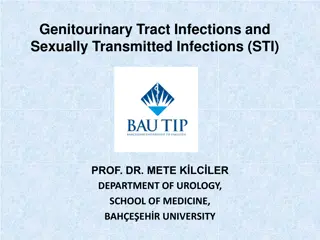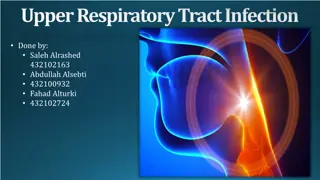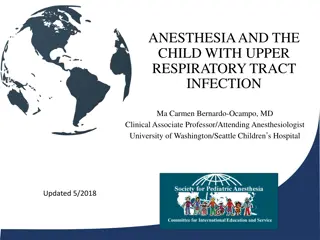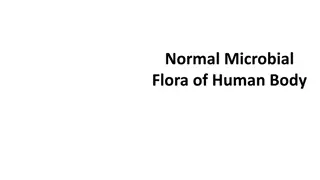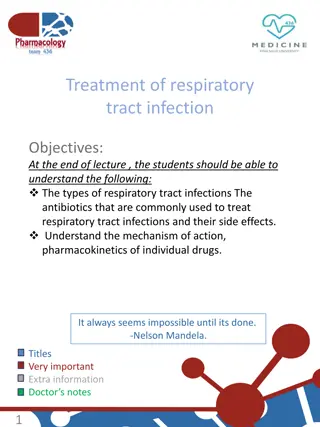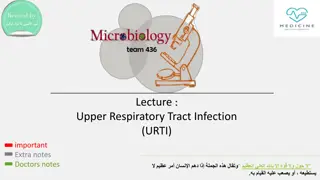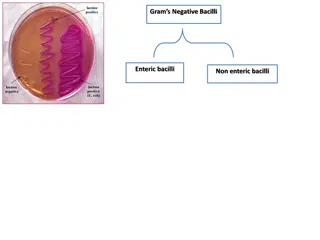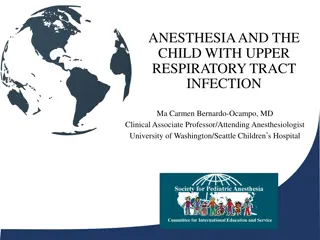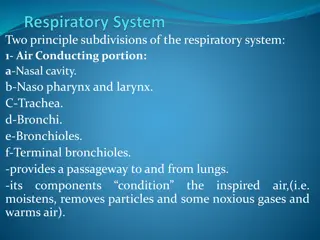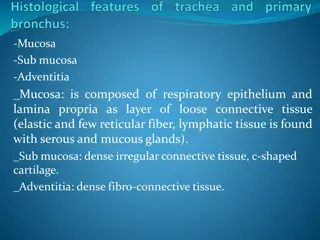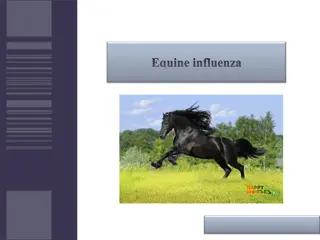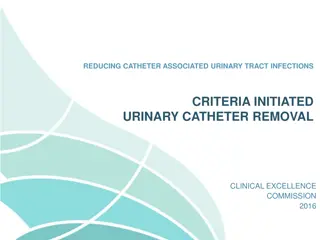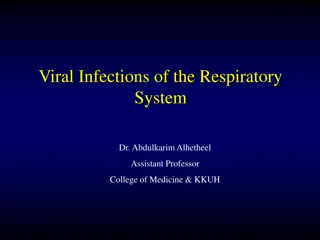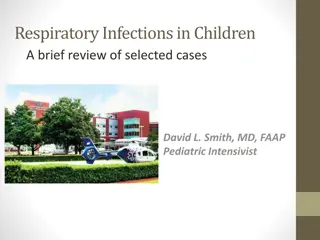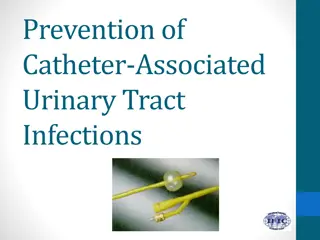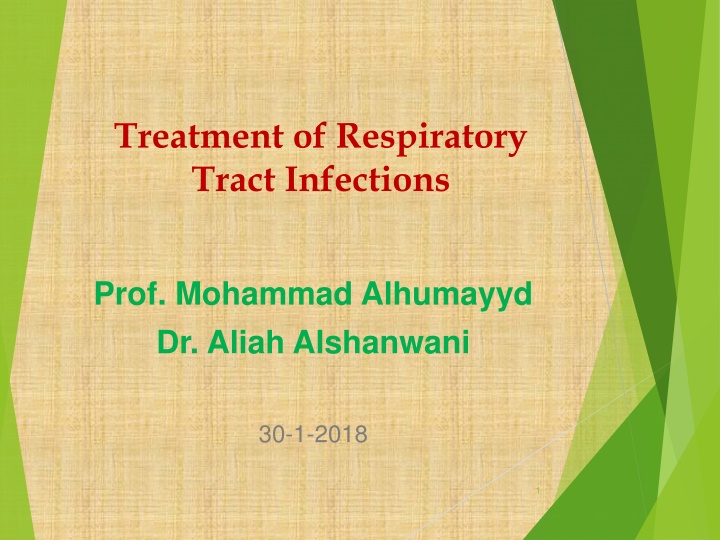
Treatment and Antibiotics for Respiratory Tract Infections
Learn about the classification of respiratory tract infections, causes, and treatment options including common antibiotics. Understand the mechanisms of action and pharmacokinetics of different drugs. Upper and lower respiratory tract infections are discussed, along with the suitable antibiotics for each type.
Download Presentation

Please find below an Image/Link to download the presentation.
The content on the website is provided AS IS for your information and personal use only. It may not be sold, licensed, or shared on other websites without obtaining consent from the author. If you encounter any issues during the download, it is possible that the publisher has removed the file from their server.
You are allowed to download the files provided on this website for personal or commercial use, subject to the condition that they are used lawfully. All files are the property of their respective owners.
The content on the website is provided AS IS for your information and personal use only. It may not be sold, licensed, or shared on other websites without obtaining consent from the author.
E N D
Presentation Transcript
Treatment of Respiratory Tract Infections Prof. Mohammad Alhumayyd Dr. Aliah Alshanwani 30-1-2018 1
Objectives of the lecture At the end of lecture, the students should be able to understand the following: The types of respiratory tract infections (RTI) The antibiotics that are commonly used to treat RTIs & their side effects Understand the mechanism of action & pharmacokinetics of individual drugs. 2
Classification of RTIs Upper respiratory tract infections (URTI) Lower respiratory tract infections (LRTI) 3
Causes of URTIs Viruses; Most URTIs are of viral etiology (Should NOT be treated with antibiotics) Treatment: rest & plenty of fluids, OTC cold & pain relievers Bacteria(mainly Group A streptococcus, H. influenza) Treatment: Antibiotics. The type depends on: Type of bacteria Sensitivity test. 5
LRTIs (costly & more difficult to treat) Bronchitis (inflammation of major bronchi & trachea) Acute, or Chronic, or Acute exacerbation of chronic bronchitis Causes: viruses or bacteria (H. influenza, Streptococcuspneumonia & Moraxellacatarrhalis). Pneumonia(Serious infection of bronchioles & alveoli) Community Acquired (CAP) Hospital-acquired Causes: Bacteria S. pneumonia**(66%), H. influenza (20%), M. catarrhalis (20%). 6
Antibiotics commonly used in the treatment of RTIs Beta-lactam antibiotics (Penicillins / Cephalosporins) Macrolides Fluoroquinolones Aminoglycosides Doxycycline. 7
Broad-spectrum penicillins Amoxicillin-Clavulanic acid Ampicillin-Sulbactam Piperacillin-tazobactam Act on both gram+ve & gram-ve microorganisms. 9
Mechanism of action of Penicillins Inhibit bacterial cell wall synthesis through inhibition of peptidoglycan layer of the cell wall. Bactericidal. 10
Pharmacokinetics of Penicillins Given po or parenterally Not metabolized in human Relatively lipid insoluble Excreted mostly unchanged in urine Probenecid slows their elimination & prolong their half live Half-life 30-60 min (increased in renal failure). 11
Hypersensitivity reactions Convulsions (after high i.v. dose or in renal failure) Adverse effects Diarrhea Superinfections Nephritis 12
Therapeutic uses of Penicillins URTIs LRTIs. 13
Mechanism of action of Cephalosporins Inhibit bacterial cell wall synthesis Bactericidal (Similar to Penicillins) Classified into 3 gps: 15
1st Generation Cephalosporins e.g. Cephalexin o Given po o Effective against gram positive bacteria o Effective in URTIs. 16
2nd Generation Cephalosporins E.g. Cefuroxime, cefaclor Given po Effective mainly against Gram-negative bacteria Well absorbed po Active against -lactamase producing bacteria Uses: Upper & lower RTIs. 17
3rd Generation Cephalosporins Ceftriaxone / Cefotaxime / Cefixime Given by intravenous route More effective against gram- negative bacilli Effective in treatment of pneumonia. 18
Pharmacokinetics of Cephalosporins Cephalosporins are given parenterally & po Relatively lipid insoluble (like penicillins) 2 Hence, do not penetrate cells or the CNS, except for third generations Mostly excreted unchanged by the kidney (glomerular & tubular secretion) Probenecid slows their elimination & prolong their half lives Half-life: 30-90 min; except ceftriaxone 4-7 hr. 19
Adverse effects of cephalosporins Hypersensitivity reactions 1 Thrombophilibitis 2 Superinfections 3 Diarrhea 4 20
Macrolides Erythromycin Azithromycin Clarithromycin 21
Mechanism of action Inhibit bacterial protein synthesis by binding to 50S subunit of the bacterial ribosomal RNA Bacteriostatic Bactericidal at high concentrations. 22
Clarithromycin More effective on G+ve bacteria Stable at gastric acidity Inhibits cytochrome P450 system Metabolized in liver to active metabolite Biliary route is the major route of elimination Only 10-15% excreted unchanged in the urine Half-life 6-8 hours. 23
Azithromycin More effective on G-ve bacteria Stable at gastric acidity Undergo some hepatic metabolism (inactive metabolite) Biliary route is the major route of elimination Only 10-15% excreted unchanged in the urine Half-life (3 days) Once daily dosing No effect on cytochrome P- 450.24
Clinical uses of Macrolides Chlamydial pneumonia Legionella pneumonia. 25
Adverse effects Hypersensitivity Reactions. 26
Fluoroquinolones Ciprofloxacin Moxifloxacin Gatifloxacin 27
Mechanism of action Block bacterial DNA synthesis by inhibiting DNA Gyrase enzyme (an enzyme involved in DNA supercoiling). 28
Antibacterial spectrum Ciprofloxacin mainly effective against G ve bacteria Moxifloxacin & Gatifloxacin G ve & G+ve & given once daily. (highly active against Pseudomonas species) 29
Pharmacokinetics Given po or parenterally Concentrates in many tissues (kidney, prostate, lung & bones/ joints) Excreted mainly through the kidney Their relatively long Half-life allow once daily (moxifloxacin & Gatifloxacin) & twice-daily (ciprofloxacin) dosing. 30
Clinical Uses Acute exacerbation of chronic obstructive pulmonary disease 1 Community acquired pneumonia 2 3 Legionella pneumonia 31
Adverse effects Nausea, vomiting, diarrhea CNS effects (confusion, insomnia, headache, anxiety) Damage of growing cartilage (arthropathy) Phototoxicity (avoid excessive sunlight). 32
Contraindications Not recommended for patients younger than 18 years Pregnancy Breast feeding women. 33
THANK YOU 34


